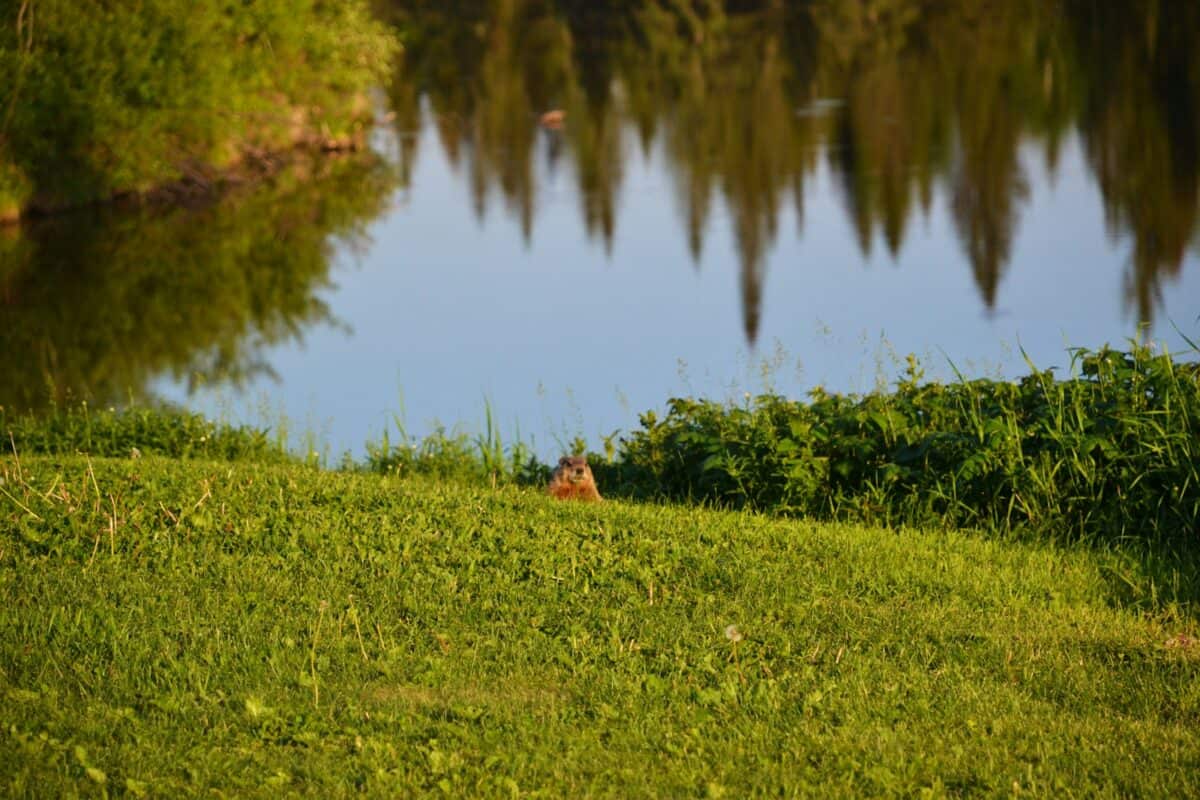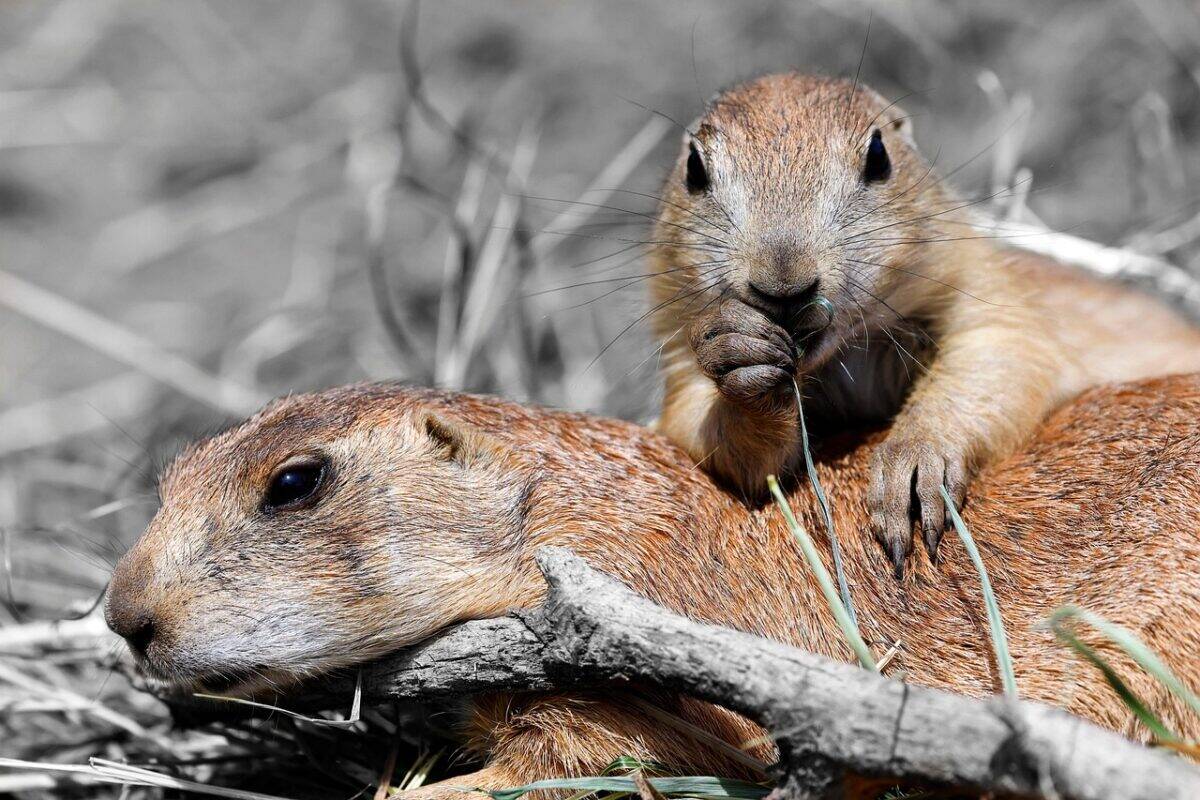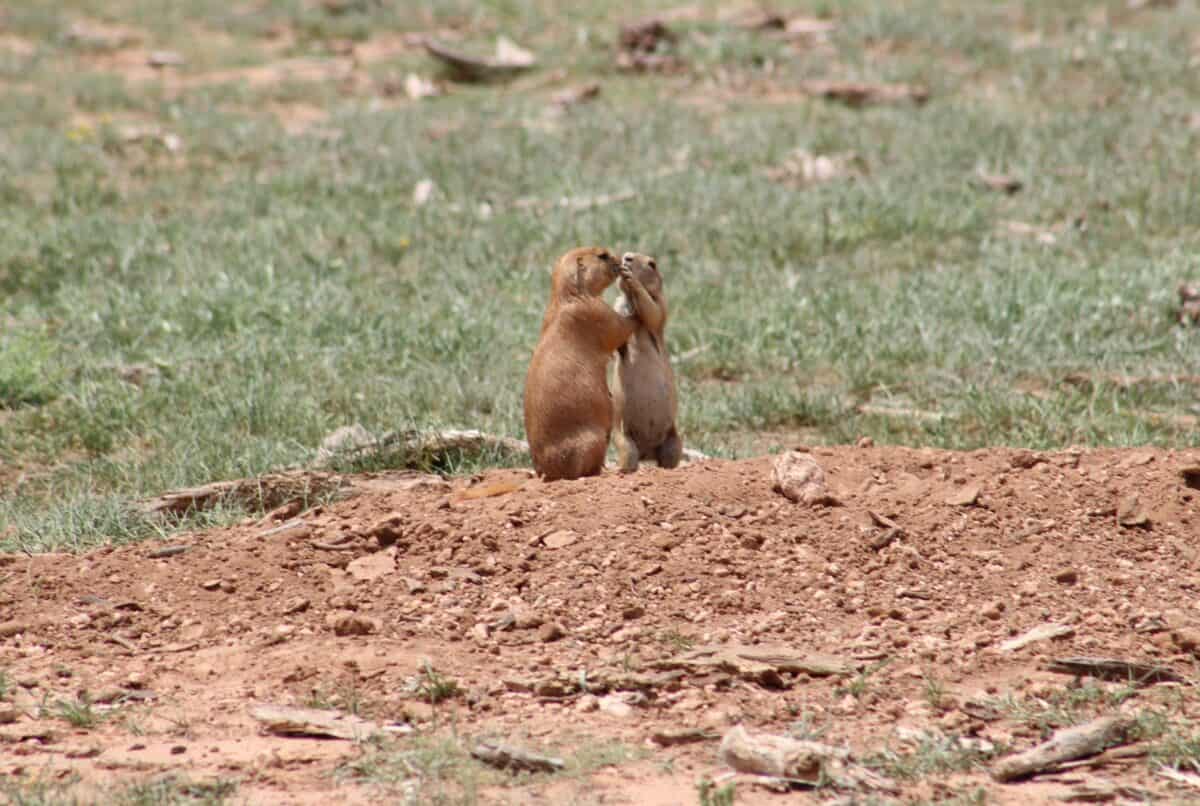Prairie dogs, those charismatic ground-dwelling rodents of North America’s grasslands, may appear to be simply cute creatures that pop in and out of burrows. However, beneath this endearing exterior lies one of the animal kingdom’s most sophisticated communication systems. These highly social animals have developed a complex language that allows them to convey specific information about predators, coordinate group activities, and maintain their intricate social structures. Scientists studying prairie dog communication have uncovered a system so nuanced that some researchers have compared it to a primitive form of language, complete with syntax and descriptive elements. This article explores the remarkable communication abilities of prairie dogs, shedding light on how these small mammals use sounds, gestures, and behaviors to create a comprehensive communication network that helps them survive and thrive in their challenging prairie environments.
The Prairie Dog: A Brief Introduction

Prairie dogs (genus Cynomys) are burrowing rodents native to the grasslands of North America. Five species exist: black-tailed, white-tailed, Gunnison’s, Utah, and Mexican prairie dogs. These highly social animals live in complex underground colonies called “towns” that can span hundreds of acres and contain thousands of individuals. Prairie dogs are diurnal creatures, spending their days foraging for grasses, seeds, and occasional insects, while remaining vigilant for predators. Their complex social structure revolves around family groups called coteries, typically consisting of one male, several females, and their offspring. This intricate social organization necessitates a sophisticated communication system to coordinate activities, warn of dangers, and maintain social bonds. Their remarkable ability to communicate has made them a focal point for researchers studying animal language and cognition.
The Discovery of Prairie Dog “Language”

The groundbreaking research into prairie dog communication began in earnest in the 1980s when Dr. Con Slobodchikoff of Northern Arizona University started recording and analyzing prairie dog alarm calls. Initially, scientists believed these vocalizations were simple, generalized alerts. However, Slobodchikoff’s meticulous research revealed something far more complex. By recording prairie dog calls in response to different predators and analyzing them using computer-based sound analysis, he discovered that prairie dogs weren’t just giving generic alarm calls—they were providing detailed information about specific predators. The research team conducted controlled experiments, having different humans wear different colored shirts while walking through prairie dog colonies, and found that the animals created distinct calls for each color. This revolutionary finding suggested that prairie dogs possessed the ability to create new “words” for novel objects in their environment, a characteristic previously thought unique to human language. This discovery has fundamentally changed our understanding of animal communication capabilities.
Alarm Calls: The Prairie Dog’s Warning System

The alarm call system of prairie dogs stands as their most studied and remarkable form of communication. When a prairie dog spots a potential threat, it immediately produces a series of high-pitched calls that alert the entire colony. These aren’t simply generic warnings—they contain specific information about the predator. The calls vary in acoustic structure depending on the type of predator (hawk, coyote, domestic dog, human), its size, shape, color, speed of movement, and proximity to the colony. For example, a call signaling an approaching coyote differs significantly from one warning about a circling hawk. This specificity allows other prairie dogs to respond appropriately: diving into burrows for aerial predators or standing at attention on burrow edges to track ground predators. Research has documented that prairie dogs can even distinguish between different humans based on their physical characteristics and previous behavior toward the colony. This sophisticated alarm system has evolved as a critical survival mechanism, allowing prairie dogs to coordinate their responses to the diverse predator threats in their environment.
The Acoustic Structure of Prairie Dog Calls

Prairie dog vocalizations consist of a series of short, staccato barks that vary in acoustic properties. These calls, often described as “chee-chee” or “yip-yip” sounds, typically last between 0.1 and 0.5 seconds and can be repeated in rapid succession. Using spectrogram analysis, researchers have identified multiple components within these seemingly simple vocalizations. The calls contain variations in frequency, amplitude, duration, and the intervals between barks. Additionally, prairie dogs utilize what scientists call “chatter”—a rapid series of calls that can communicate excitement or agitation. The most common alarm call, known as the “jump-yip,” involves a prairie dog stretching upright while emitting a distinctive vocalization. Sophisticated computer analysis has revealed that these calls contain at least 20 different acoustic parameters that can be varied to create different “words.” The combination of these acoustic elements allows for an estimated vocabulary of potentially hundreds of distinct call types, each conveying specific information. This acoustic complexity rivals that of some non-human primates and challenges traditional views of rodent communication capabilities.
Predator-Specific Information in Prairie Dog Calls

The most fascinating aspect of prairie dog communication is their ability to encode predator-specific information in their alarm calls. Research by Dr. Slobodchikoff and his team has demonstrated that prairie dogs create distinct vocalizations for different predator species. When analyzing the calls, researchers found that prairie dogs don’t just identify the type of predator but also communicate additional details. Their calls can specify the predator’s size, shape, direction of movement, speed, and even color. In controlled experiments, prairie dogs consistently produced different calls when humans wearing blue shirts versus red shirts approached their colonies. Similarly, they created distinct vocalizations for tall versus short humans or fast versus slow-moving threats. This level of descriptive ability suggests a communication system with linguistic properties previously thought impossible for non-primate species. When a particular call is played back to prairie dogs, they respond appropriately to the specific threat described, confirming that these calls contain meaningful information understood by all colony members. This remarkable specificity helps the entire colony respond appropriately to each unique threat scenario.
Beyond Alarm Calls: Social Communication

While alarm calls have received the most scientific attention, prairie dogs employ a much broader communication repertoire for social interactions. Greetings between colony members often involve a series of vocalizations accompanied by physical contact, including what researchers call the “kiss.” During this greeting, prairie dogs briefly touch their teeth together—a behavior that helps identify colony members and reinforces social bonds. Prairie dogs also use distinct calls during territorial disputes, mating rituals, and when coordinating group activities like foraging. Mothers and pups communicate through specialized calls that help maintain contact and signal distress. Dominance interactions are mediated through a combination of vocalizations and body postures, with higher-ranking individuals using specific call types to assert their status. These social communications help maintain the complex social structure of prairie dog towns, allowing hundreds or thousands of individuals to live cooperatively in close proximity. Research suggests that each prairie dog may have individualized call characteristics, potentially allowing for recognition of specific colony members—similar to humans recognizing familiar voices.
Visual Communication and Body Language

Vocal communication in prairie dogs is complemented by an elaborate system of visual signals and body language. Prairie dogs use a variety of postures to communicate different states and intentions. The classic “jump-yip” display involves a prairie dog standing on its hind legs, stretching to full height, and calling loudly—a behavior that appears to communicate all-clear status and may help coordinate colony activities. Tail movements serve as important visual signals, with different patterns indicating various emotional states or intentions. A rapidly flicking tail often signals agitation or alarm, while a relaxed tail indicates calm. During territorial disputes, prairie dogs engage in what researchers call “tail-spreading displays,” where the tail is fanned out to appear larger. Facial expressions, though subtle to human observers, communicate important information between prairie dogs. They also use physical contact—grooming, nuzzling, and play-fighting—as forms of tactile communication that strengthen social bonds. These visual and physical communication methods work in concert with vocalizations to create a multi-modal communication system that functions effectively even in the visually limited underground environment of their burrows.
The Development of Communication Skills in Young Prairie Dogs

Prairie dog pups begin developing their communication skills almost immediately after birth. Born blind and hairless, they initially rely solely on vocalizations to communicate needs to their mothers. As they mature over the first six weeks of life, young prairie dogs gradually acquire the full vocal repertoire of adults through a combination of innate development and social learning. Researchers have observed a clear progression in communication sophistication as pups grow. Initially, they produce simple, undifferentiated calls, but by about three months of age, they can produce adult-like alarm calls. Interestingly, young prairie dogs appear to go through a “practice” phase where they produce alarm calls that gradually become more precise and specific. Mother prairie dogs actively “teach” their young about predators by producing alarm calls when threats are present, demonstrating appropriate responses, and sometimes physically repositioning pups to observe potential dangers. This developmental process suggests that while prairie dogs have innate communication abilities, their sophisticated alarm system requires a period of learning and refinement. Studies tracking individual pups show that those with more social interactions develop more nuanced communication skills, highlighting the importance of social learning in this process.
Regional “Dialects” Among Prairie Dog Colonies

One of the most intriguing aspects of prairie dog communication is the existence of regional variations or “dialects” between different colonies. Research comparing alarm calls across geographically separated prairie dog towns has revealed subtle but consistent differences in acoustic structure, even when the calls refer to the same predators. These dialects appear to develop and persist even when colonies are relatively close to each other, suggesting they are culturally transmitted rather than adaptations to different environmental conditions. Prairie dogs from different colonies can generally understand each other’s alarm calls at a basic level, but research suggests they respond more precisely to the specific dialects of their own colony. These regional variations appear to be maintained through social learning, with young prairie dogs adopting the specific acoustic patterns of their natal colony. The existence of these dialects provides compelling evidence that prairie dog communication has cultural components similar to human language variations. Some researchers speculate that these dialects may serve as a form of group identity marker, helping prairie dogs distinguish colony members from outsiders. This phenomenon of regional variation adds another layer of complexity to the already sophisticated communication system of these remarkable rodents.
The Evolutionary Advantages of Complex Communication

The evolution of such a sophisticated communication system in prairie dogs provides several critical survival advantages. The ability to communicate specific predator information allows for more efficient predator avoidance strategies, significantly increasing survival rates. Rather than all colony members retreating underground for any potential threat, prairie dogs can tailor their responses appropriately—staying alert but visible for distant threats while taking immediate cover for imminent dangers. This selective response balances safety with necessary activities like foraging. Complex social communication facilitates the maintenance of their intricate social structure, which itself provides benefits through shared vigilance, cooperative rearing of young, and coordinated defense of territory. The communication system also supports efficient resource allocation, allowing prairie dogs to coordinate foraging activities and avoid competition within the colony. From an evolutionary perspective, the cognitive demands of maintaining such a complex communication system may have driven the development of higher cognitive abilities in prairie dogs compared to solitary rodent species. The sophistication of their communication reflects the intense selection pressures of living in open grasslands with high predation risks, demonstrating how communication complexity can evolve as an adaptation to challenging environments.
Comparing Prairie Dog Communication to Human Language

The complexity of prairie dog communication has prompted researchers to consider its similarities and differences compared to human language. While prairie dog communication shares several characteristics with human language—including referentiality (calls refer to specific objects or events), productivity (the ability to create new signals for novel situations), and displacement (communicating about objects not immediately present)—important distinctions remain. Prairie dog communication appears to lack the recursive structure of human language, where phrases can be embedded within other phrases to create infinite meaning combinations. Additionally, while prairie dogs can communicate about concrete threats and social situations, there’s no evidence they can express abstract concepts or hypothetical scenarios as humans do. Nevertheless, their communication system challenges traditional linguistic boundaries and suggests that the gap between human language and animal communication may be smaller than previously thought. Some researchers argue that prairie dog communication represents a form of proto-language that shares foundational elements with human language but lacks its full syntactic complexity. This comparison provides valuable insights into how complex communication systems might have evolved in our own species and highlights the diverse ways intelligent animals have developed solutions to communication challenges.
Modern Research Methods and Technological Advances

The study of prairie dog communication has been revolutionized by technological advances in recent decades. Early research relied primarily on human observers recording behavioral responses to calls, but modern studies employ sophisticated audio recording equipment capable of capturing the ultrasonic components of prairie dog vocalizations inaudible to human ears. These high-definition recordings are then analyzed using specialized software that can identify subtle acoustic patterns and variations invisible in traditional spectrogram analysis. Machine learning algorithms have been particularly valuable, allowing researchers to identify patterns in thousands of call samples that would be impossible to detect manually. Remote monitoring systems now enable scientists to record communication in natural settings without human presence influencing behavior. Some researchers have begun using portable speakers to play synthesized prairie dog calls in controlled experiments, testing specific hypotheses about what information is being conveyed. DNA analysis has complemented communication studies by clarifying the genetic relationships between individuals, helping researchers understand how kinship influences communication patterns. The most cutting-edge research involves attempts to “decode” prairie dog language using artificial intelligence, with some preliminary success in translating certain alarm calls into English equivalents. These technological advances continue to deepen our understanding of just how sophisticated prairie dog communication truly is.
Conservation Implications of Prairie Dog Communication Research

Understanding the sophisticated communication system of prairie dogs has important implications for conservation efforts. Prairie dogs are considered a keystone species in grassland ecosystems, creating habitat that supports hundreds of other species. Despite their ecological importance, prairie dog populations have declined by over 95% in the past century due to habitat destruction, systematic eradication campaigns, and sylvatic plague. Research on their communication abilities has helped shift public perception of prairie dogs from agricultural pests to intelligent, socially complex animals worthy of conservation. This changing perception has influenced policy decisions regarding prairie dog management and protection. From a practical conservation standpoint, knowledge of their communication provides tools for population monitoring and management. Researchers can use playback of recorded alarm calls to elicit responses that help estimate population sizes and health. Understanding how prairie dogs communicate about environmental threats helps conservation biologists predict and mitigate their responses to habitat disturbances. Additionally, their sensitivity to environmental changes, as reflected in their communications, makes prairie dogs valuable bioindicators of ecosystem health. For reintroduction efforts, maintaining social groups with established communication patterns appears critical for colony success, as relocated individuals that maintain their social bonds and communication networks show significantly higher survival rates. Thus, research into prairie dog communication not only advances our scientific understanding but directly contributes to more effective conservation strategies for these ecologically vital animals and their grassland habitats.
The communication system of prairie dogs represents one of nature’s most sophisticated examples of animal language, challenging our understanding of non-human communication capabilities. Through decades of careful research, scientists have revealed a system that goes far beyond simple alarm calls to include detailed information about predators, social coordination, and colony maintenance. The complexity of prairie dog communication—with its predator-specific descriptions, regional dialects, and sophisticated development process—demonstrates that advanced communication is not limited to primates or other animals traditionally considered “intelligent.” This research carries profound implications for our understanding of animal cognition, the evolution of language, and the conservation of these remarkable creatures. As technology advances and research methods become more sophisticated, we will likely discover even greater depths to prairie dog communication, potentially revealing capabilities we can’t yet imagine. In protecting prairie dogs and their diminishing habitat, we preserve not just an ecological keystone species but also one of the animal kingdom’s most fascinating communication systems—a living laboratory for understanding how complex language abilities evolve in response to social and environmental challenges.
- America’s Most Endangered Mammals And How to Help - August 9, 2025
- The Coldest Town in America—And How People Survive There - August 9, 2025
- How Some Birds “Steal” Parenting Duties From Others - August 9, 2025

